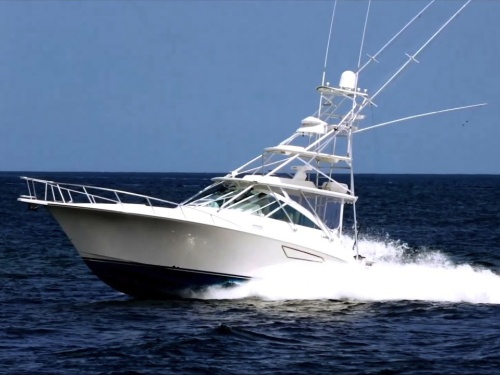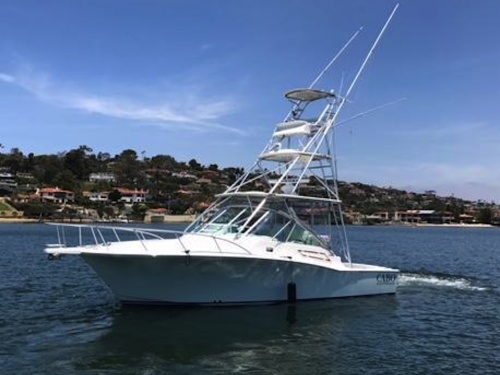Access More Boat Tests
Already have an account? Login
Cabo 36 Express (2011-)
Brief Summary
There are a dozen or so builders that make express fishboats in the mid-30-foot range, so making a decision as to which one to buy is not an easy one. Some of these express fish boats are built by large companies, some by small yards, some of the builders specialize in large convertibles and others specialize in small WA's or center consoles. But in its 20 years of existence Cabo has always targeted the offshore fishing market in the 30' to 50' range as its main enterprise and focus.
Specifications
| Length Overall | 38' 6'' / 11.7 m |
|---|---|
| Beam |
14' 2'' 4.32 m |
| Dry Weight |
25,750 lbs. |
| Draft |
3' 1'' 0.94 m |
| Deadrise/Transom | 17.5 deg. |
| Max Headroom |
6' 3'' 1.91 m |
| Bridge Clearance | N/A |
| Fuel Capacity |
400 gal. 1,514 L |
| Water Capacity |
100 gal. 379 L |
Engine Options
| Tested Engine |
Currently no test numbers |
|---|---|
| Std. Power |
Not Available |
| Opt. Power |
Twin Caterpillar C7 ACERT, 461HPM Twin Caterpillar C9, 575HPM Twin Cummins QSB5.9, 425HPM Twin Yanmar 6LY3A-ETP, 480HPM Twin Yanmar 6LY3A-STP, 440HPM |
Captain's Report
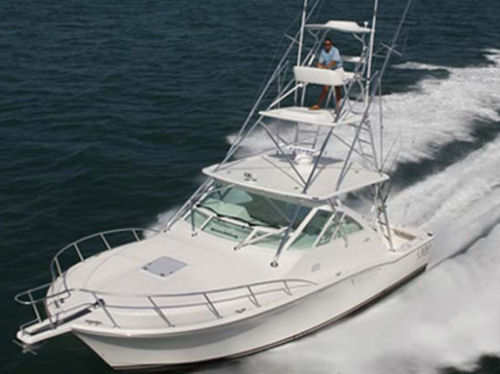
As its name implies, Cabo was conceived as a line of fishing boats for anglers, running out of the harbor at Cabo San Lucas in Baja, California hell-bent on raising billfish. And since many of their customers would live in Southern California, their boats would have to be able to make the 1600-mile run down to Cabo in all sorts of offshore conditions. Further, because fuel stops are few and far between along the Mexican Baja coast, its boats would have to have good range and be as fuel-efficient as possible.
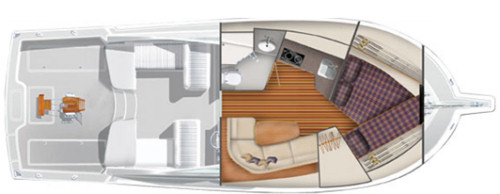
While great bill fishing can be had relatively close to land off Cabo San Lucas and in the Sea of Cortez, the prodigious range of the new Cabo 36 Express also comes in handy on the U.S. East Coast where anglers need to go 100 miles or more out to the canyons. And over the years Cabo has also gained a good international following where range is important.
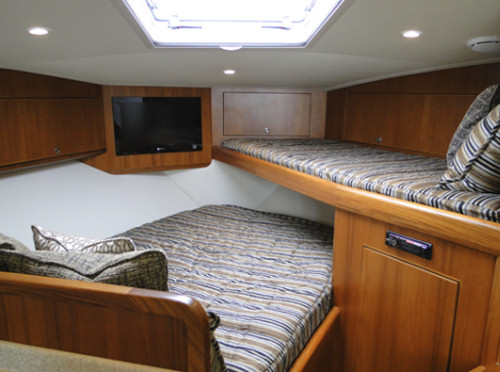
Out With the Old
The new Cabo 36 Express replaces the old 35 that the company built for years quite successfully. Obviously, the new boat includes all of the good suggestions that scores of 35 owners have passed along to Cabo, so the 36, while new, has really been time-tested and is by no means a pig-in-a-poke.
There are six major changes between the new 36 Cabo and the old 35:
1) The boat's footprint in the water is decidedly bigger. She is a foot longer overall and her beam is 1'2" ( 35.5 cm) more. That makes a big difference.
2) All of the extra material required to make the footprint bigger has added about 8,000 lbs. (3,636 kgs.) in weight. That will make her ride better, but harder to push.
3) Her deadrise at the transom has been increased from 16-degrees to 17.5-degrees. This does not seem like a big change, but it moves her from having one of the flattest deadrises in class to somewhere in the middle. Like the added weight this change will make her more comfortable at speed in a seaway, but also harder to push.

4) With greater length and beam has come more interior space from stem to stern. This has allowed a number of good things to happen below, on the bridge deck and in the engine room.
5) In the sleeping area forward there is now an over and under bunk arrangement with a double to port and a single to starboard. This makes a lot more sense for a fishing boat for men. Cabo says it has "5 berths" instead of four. Let's just say the boat will now sleep three men comfortably instead of two.
6) On the bridge deck on the port side Cabo has made another important change by creating a wide companion seat big enough for two people to face forward. We are big believers in having as many eyes as possible facing forward and it is a lot more comfortable. This arrangement replaces the L-shaped settee in the 35. By having the companion seat back flip forward it has crated a aft-facing L-shaped settee, so now it has the best of both worlds.
Owned by Brunswick/Built by Hatteras
The Cabo 36 is in the "sweet spot" for inboard-powered fishing boats. That's where there are good sales numbers because it is a step up from center consoles, yet not so big that you get into the big cash out-lays and operating costs of a large convertible. Also, convertible owners trading down find that as a day boat, an express in the mid-30s gets the job done and is comfortable. Sales for these sized boats and Cabo were brisk in the 1990s and 2000s when the economy was humming.
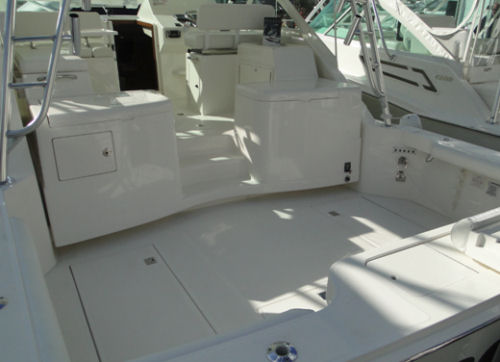
That is why Brunswick bought the company a few years ago. By late last year all Cabo production had been shifted from its California plant to the Hatteras factory in New Bern, N.C. Hatteras, of course, is a far older and more experienced builder but its engineering staff and that of Cabo are both singing from the same songbook. We can only imagine that there will be lots of positive cross pollination now that Cabo is in New Bern, so a good boat should get even better. Also, the men on the shop floor grew up in the New Bern and Outer Banks area -- a sportfishing Mecca -- so there is no doubt in our mind that the Cabo brand is in good hands all around.

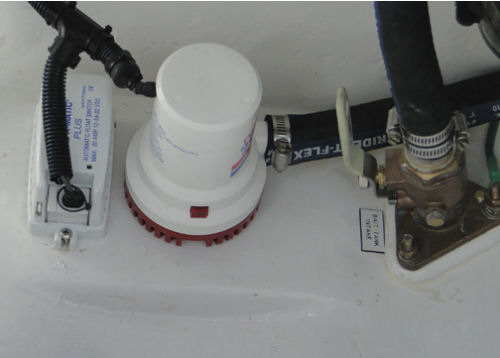
A 36 For Fishy Men
The new 36 Express has all of the fishing amenities we would expect to find in such a boat -- live bait well in the transom, padded bolsters around the coaming, two huge fish boxes in the cockpit sole, a bait prep console to port with sink and tackle drawers and an optional refer/freezer in the starboard console. All of this is pretty much SOP for express fishboats but what sets the Cabo 36 apart from some of the lower-priced competitors is her fit-and-finish, attention to detail, and engineering.
One thing on the Cabo that is not seen on all express fishboats is the treatment of the transom door. The transom door opens out, as it should to quickly dewaters the cockpit if a sea comes aboard when backing down on a fish. Some builders have the door opening in because they think that is safer if someone falls against it. Cabo solves that worry by having a transom gate that folds back from above the door. In that way the door can be open but the gate closed. This is the best way to handle a transom door in any boat of this type, in our opinion.

By the way, the cockpit sole is 8" (20.3 cm) above the waterline. This is an important metric to check on any sportfishing boat. One wants to make sure that the deck is not too low to the water, in which case waves sloshing against a drifting boat can wash in the scuppers. But on the other hand you also don't want to be so high off the water that boating a fish, gaffing and bringing a fish to wire is difficult.
Man-Sized Pleasure
The place where the new Cabo 36 starts to put some distance between herself and some other brands in class is in her engine room, bridge deck, and down below. Essentially, the most important single aspect of this boat is that she was designed and built for big men. That might sound obvious for an offshore fishing boat, but you must remember that we are talking about 36 feet here, and not a huge battlewagon. What Cabo's designer, Michael Peters, was able to do in these confines is impressive.

First, the Cabo 36 is one of the most beamy boats in class. The builder carries most of that beam down to the waterline unlike other builders who reduce the waterline beam as much as possible to save weight, money, and to make it easier to push the boat.
Second, on the bridge deck Cabo has been able to install two double-wide seats facing forward. On the starboard side is the helm seat with plenty of room for the navigator. To port is the companion seating which is also facing forward and there is ample room for two large people.
Third, there is more room in the accommodations plan below. The head has been reconfigured and now the separate shower stall is much bigger and the toilet is away from the sink which means that if a couple is aboard they both can be used at once. Forward on the port side is a double berth, just as before, but now there is sufficient beam forward to install a single berth.
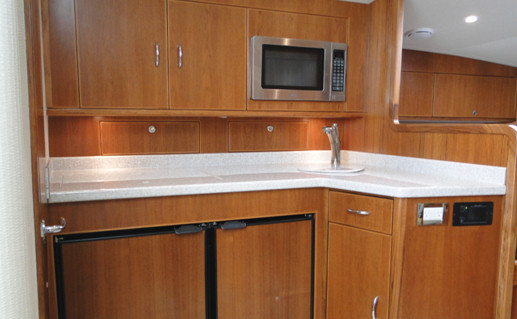
More Wood Below
In the 1990s Cabos were known for being a bit Spartan below. There was wood, but no more than there really had to be in many cases. After all, these boats were not intended to be feminized cruising boats, but rather a boat for real men (and women) of the fishy kind. On the new Cabo 36 we recently went aboard there was much more wood which gave the boat a classier and cozier appearance, at least to our eye.

Comparison with Other Boats in Class
Not only is the new Cabo 36 bigger than the old 35, she is also a big 36 when compared with other boats in class. She is actually 38'6" (11.8 m) on overall, with a 14'2" (4.35 m) beam and has a dry weight of 27,500 lbs. (12,500 kgs.). At that displacement she is actually 3,000 lbs to 10,000 lbs heavier than some other express fishboats about this size. In fact, only one boat was heavier in our comparison research.

That weight may mean she is not as fast as some other boats with the same engines, but with a 17.5-degree deadrise bottom at the transom she will even-up the score somewhat with boats with a deeper modified-V boat which will be slightly harder to push. She is also one of the beamest boats in class and that together with her longer waterline distributes her weight over more surface area which gives her the shallowest draft in class at 37" (94 cm). That could be an important attribute to someone who likes to fish in skinny water or who has a dock that gets dicey in moon tides.

Belly of the Beast
Cabo offers seven power options for the 36 Express from Yanmar, Cat, and Cummins. Horsepower ranges from 425 to 575. The drive system is a conventional inboard system with a straight shaft. The engine room and bilge is painted white in linear polyurethane paint for simple cleanup. While there is a quick accesses hatch in the bridge deck to the engine room, like most express fishboats this size, the bridge deck opens up by tilting forward.
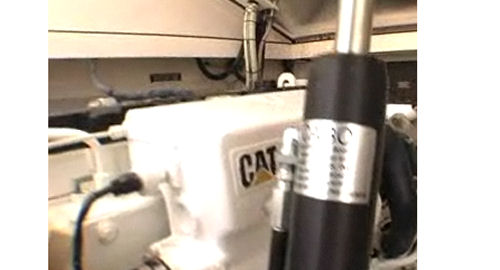
What sets the Cabo 36 apart from some other boats is that two huge hydraulic rams lift open the bridge deck and tilt it farther forward than on many boats we have seen. As a result you can actually enter the engine room standing up, not slithering in as we have had to do in some boats. Once inside, there is plenty of room between the engines, forward of the engines, and on the outboard side of the engines so even a portly owner has no excuse for not checking his fluids, the sea strainers, fuel filters, seacocks and other equipment before shoving off each morning.
The other thing one immediately notices upon entering the engine compartment is how clean and well-organized everything is. Virtually all of it is labeled so there can be no misunderstanding about what thru-hull is feeding which piece of equipment. Cabo uses industry best practices when it comes to both materials and installation. For example, its fuel lines are fire-retardant, aircraft-grade braided steel, and solid rubber grommets are used to protect wiring from chafe where it is run through bulkheads. Underwater thru-hulls are all bronze and are bonded.
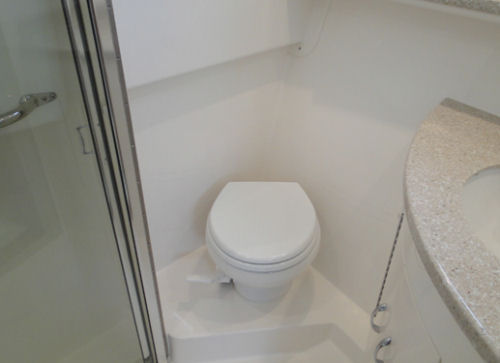
Construction
The 36 like all Cabos was designed by Michael Peters Yacht Design which is responsible for the stylish lines as well as the bottom shape and major geometry of the boat. Cabo uses biaxial stitched fiberglass in its vacuum-bagged layup to maximize the glass to resin ratio of the hull. The resin used is vinylester which stops water osmosis and blistering, and is the industry standard in class. Cabo also bonds the interior accommodations module with the inside of the hull which gives the hull extra stiffness.

Recommendation
Cabo has built its much-deserved good reputation on delivering good value for money, but with the emphasis on quality and functionality, not on being the lowest cost boat on the block. This has given consumers a far more desirable choice than one of going with the cheapest brand or the gold-platter. Cabo tries to keep its boats as simple as possible and avoids the gimcracks that are cool, but only drive up initial cost and often create maintenance bills. The price of the boat that we have described above at the recent Miami Boat Show was $638,456 powered with Cat C9 575-hp twin diesels. There are a few options in that price such as a tuna tower, A/C, cockpit freezer, teak and holly sole below and the Westerbeke generator.
If you are undecided about an express fishboat in this size range we would use the Cabo 36 as a good bench mark as a boat that is built right, but not overly expensive.


